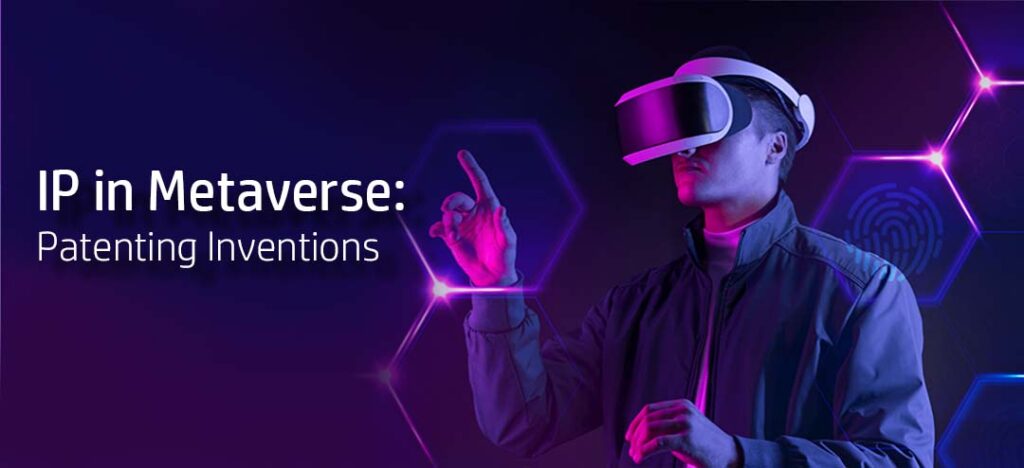It’s anticipated that companies and creators will have new opportunities to offer hardware and software for augmented reality (AR) and virtual reality (VR) devices when internet connectivity gives way to the Metaverse. They will aim to increase usability as technology develops, making such devices more accessible and durable. Intellectual property (IP) rights are immediately affected as more innovations become patented. As brands for tangible and digital goods, services, and tools begin to emerge, a virtual trademark area will be created. IP assets will exist in both the real and virtual worlds. The platform’s advancement depends on user-generated content. In terms of trademarks, brands will primarily be distinguished by non-traditional markings like auditory marks, animated graphic marks, etc. A new class of goods and services, such as downloadable digital content, retail outlet services for digital content, and internet entertainment services, will need to be established since completely new items and services will enter the market. While software-related inventions, including games, will be subject to copyright protection, physical things like eyewear and other devices will be protected by patents. However, there are difficulties in patenting this cutting-edge technology.
Technology to power the Metaverse is being vigorously developed and patented by many IT giants. Such patented technologies include for example, systems for maximizing shared views of virtual objects to numerous VR headset users, algorithms for creating and starting to move simulated shapes and scenes in a VR world based on hand gestures, head movement, or line of vision of the user, systems for producing haptic feedback relating to users’ engagement with virtual elements in a virtualized world, and techniques for creating 3D characters of the users that simulate the use of the technology.
What inventions qualify for patent protection?
In general, patent applications can be submitted on both the software operations running within the metaverse framework and the hardware parts connected to it.
Software advancements might comprise operations carried out within the metaverse framework, operations for accessing the metaverse framework, and operations for synchronizing metaverse framework states. The metaverse will mostly be constructed by modeling real-world or fictional environments and circumstances.
Hardware advancements can take the form of improved CPUs and GPUs that are designed to host or assist the metaverse framework as well as actual access tools like extended reality headsets.
Challenges in Filing Metaverse Patent Applications
- The need for innovation and creativity will likely be a significant hurdle because the virtual reality and augmented reality headset space is currently extensively patented.
- It is challenging to prosecute patent applications for virtual technology because of the strict subject matter validity rules imposed on software inventions under 35 USC 101 as a result of the US Supreme Court’s decision in Alice Corp v. CLS Bank.
- The evaluation of a metaverse-based invention’s novelty and non-obviousness by establishing if the process used within the metaverse environment is identical to the same approach used outside of it presents a significant challenge for software patents. If the claimed invention’s only difference from the prior art is that it is only applicable to the metaverse, it might be difficult for applicants to defeat it.
- As shown in European Patent Office (EPO) judgment G1/19, patenting innovations for simulation can be challenging through the EPO.
Solutions in Filing Metaverse Patent Applications
- There may be a wide range of areas in which metaverse hardware can be enhanced, even though this makes patenting challenging in a crowded field.
- By carefully observing changes in the Federal Circuit case law and USPTO investigation guidelines, patent attorneys have developed a variety of claim drafting approaches and reasonable arguments that consistently satisfy these subject matter regulations to successfully obtain patents.
- Patent attorneys should emphasize technical advancements of the technology, including technical steps that can be asserted as non-abstract, and make sure that a specification fully develops a problem-solution pair that can be linked to a practical application to prevent Section 101 rejections from the start.
- A computer program may be eligible for a grant by EPO by including certain technical elements in the patent claims.
Instances of Patents Granted in Metaverse
The instances of patent applications made by high-tech businesses to safeguard innovative technologies relevant to the Metaverse:
SONY
- Sony Interactive Entertainment recently received a patent from the USPTO on techniques for impacting the game industry (US 11,192,027). The idea for the innovation in the patent came to mind while creating the video game “Death Stranding,” which has online realms full of human-controlled avatars that players may access from anywhere in the real world. Cities surrounded by the uninhabited, natural landscape can be found in the virtual worlds. at least initially.
- In 2014, a significant Supreme Court decision carved out an exemption to the rule that anything created by humans is subject to US patent law. The Supreme Court ruled that technologies that use generic computers to accomplish human activities are disqualified. In the Alice Corp. lawsuit, several patents were asserted about a computer system that acts as a middleman for electronic payments. This ruling rendered several patents invalid and made it more difficult to obtain software-related patents.
- During the prosecution of the Sony patent, the USPTO Examiner contended that cutting through the natural world to make a path is a human activity. The network of servers that implements the virtual routes can also be thought of as a type of computer. However, other Federal Circuit cases following the Alice Corp. ruling have established exceptions to the exception, providing, pathways for software patent applicants to reach approval.
- The USPTO issued instructions for its examiners to refer to while examining patent applications as a result of the string of Federal Circuit cases. According to the rules, when a claimed abstract notion is incorporated into a practical application, it becomes eligible for patent protection, which is one of the exceptions to the rule. Attorneys for Sony made the above assertion, and the Examiner agreed.
DISNEY
- Disney has been granted a patent to create engaging, custom attractions for theme park guests in the metaverse using simultaneous localization and mapping (SLAM) (US11210843B1).
- On December 28, 2021, the organization received approval for a patent for a “virtual-world simulator in a real-world setting.”
- With the aid of 3D projection-based imaging, this method will be utilized to map park visitors’ environment as they walk around the real world. To provide visitors with a truly immersive but individualized experience, holograms of their favorite Disney characters, works of art, or information will be projected onto 3D items.
- It’s not a new idea; other theme parks have employed AR and VR to create interactive theme parks. Mario Kart-style racing is recreated as visitors experience Mario Karts: Koopa’s Challenge at Super Nintendo World while seated in a kart and using an AR headset. The headset shows animated characters that all take place in real-world settings, allowing users to race on recognizable tracks and fire the iconic shells at rivals.
- Disney, however, has shown that it strives to outperform its rivals. The simulator can be used without any additional gear, according to Disney’s patent. Instead, to create the 3D view, the simulator uses numerous projectors that produce a tremendous volume of images per second. Visitors wouldn’t need bulky headgear to experience augmented reality, making the experience more immersive and resembling the metaverse.
Conclusion
The question of how to protect intellectual property on the Metaverse still arises, despite the fact that the Metaverse offers new and intriguing prospects for creators, innovators, enterprises, and consumers of cutting-edge technology.
In conclusion, it looks to be challenging but not impossible to protect software ideas related to the metaverse, there is undoubtedly room for creativity. There is ample opportunity to secure protection for all varieties of metaverse inventions, although caution should be used to place the software innovations in a patent-friendly approach.
It is crucial for inventors to keep up with the latest developments and monitor important patent applications that could either pose a danger or an opportunity in this rapidly expanding industry.
Companies that want to join the Metaverse seem to need to move quickly if they intend to keep their place in virtual reality. The moment to take action is definitely now, whether it be by obtaining licenses or submitting patents on their own, as can be seen by the flood of patents that have already been filed for and the quantity of turnover that has already been made, with even more to be anticipated. For businesses to securely navigate a complex patent landscape, it is also now the right time to try to be ahead of the forthcoming wave of patents. Companies that are eager to comprehend it and take advantage of the emerging opportunities will find the Metaverse to be a rewarding environment. The Metaverse seems to have the opportunity to fundamentally alter enterprises as we currently know them, especially in the areas of sales and marketing. It will be interesting to observe how the actual world of patents and the virtual environment of the Metaverse interact.
How Can IeB Help You?
Ingenious e-Brain is a global provider of intellectual property, technology, commercial, and market research solutions. Ingenious e-Brain creates solutions that are adapted to your company’s needs. Our staff assists clients in all parts of their business with a unique blend of skills, proven processes, and knowledge base. With the help of our experience in drug life cycle management, IeB can provide actionable insights into the drug repositioning space by identifying drug-target receptor pathways, emerging repositioned drugs, and competitors’ strategies. IeB can also provide answers to various other queries using a variety of problem-solving techniques.
Article by Ingenious e-Brain:-
Contact us:-
US Office:-
4 Heinrick Way Bridgewater,
New Jersey 08807, USA
Phone:-
+1 347 480 2054
+1 202 697 9162
India Office:-
207-208 Welldone TechPark, Sohna Road
Sector 48, Gurugram,Haryana 122018, India
Phone:-
+91 124 429 4218
Email:-
contact@iebrain.com



